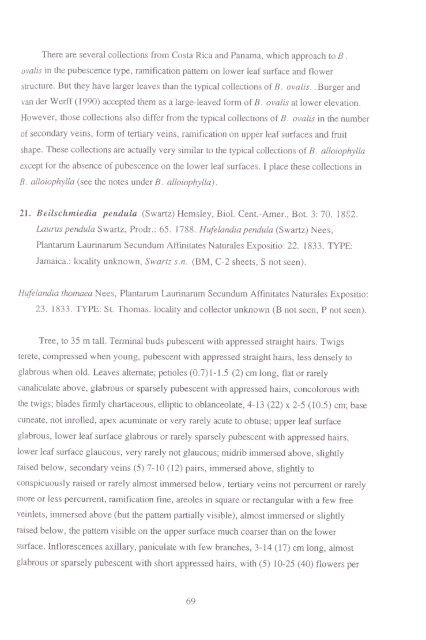Revisional study of neotropical Beilschmiedia species (Lauraceae ...
Revisional study of neotropical Beilschmiedia species (Lauraceae ...
Revisional study of neotropical Beilschmiedia species (Lauraceae ...
Create successful ePaper yourself
Turn your PDF publications into a flip-book with our unique Google optimized e-Paper software.
There are several collections from Costa Rica and Panama, which approach to B.<br />
ova/is in the pubescence type, ramification pattern on lower leaf surface and flower<br />
structure. But they have larger leaves than the typical collections <strong>of</strong> B. ova/is . . Burger and<br />
van der Werff (1990) accepted then1 as a large-leaved forn1 <strong>of</strong> B. ova/is at lower elevation.<br />
However, those collections also differ from the typical collections <strong>of</strong> B. ova/is in the number<br />
<strong>of</strong> secondary veins, form <strong>of</strong> tertiary veins, ramification on upper leaf surfaces and fruit<br />
shape. These collections are actually very similar to the typical collections <strong>of</strong> B. alloiophylla<br />
except for the absence <strong>of</strong> pubescence on the lower leaf surfaces. I place these collections in<br />
B. alloiophylla (see the notes under B. alloiophylla).<br />
21. Beilscluniedia pendula (Swartz) Hen1sley, Bioi. Cent.-Amer., Bot. 3: 70. 18~2.<br />
Laurus pendula Swartz, Prodr.: 65. 1788. Hufelandia pendula (Swartz) Nees,<br />
Plantarum Laurinarum Secundum Affmitates Naturales Expositio: 22. 1833. TYPE:<br />
Jamaica.: locality unknown, Swartz s.n. (BM, C-2 sheets, S not seen).<br />
Hufelandia thomaea Nees, Plantarun1 Laurinarum Secundum Affmitates Naturales Expositio:<br />
23. 1833. TYPE: St. Thomas. locality and collector unknown (B not seen, P not seen).<br />
Tree, to 35 m tall. Terminal buds pubescent with appressed straight hairs. Twigs<br />
terete, compressed when young, pubescent with appressed straight hairs, less densely to<br />
glabrous when old. Leaves alternate; petioles (0. 7) 1-1.5 (2) cn1 long, flat or rarely<br />
canaliculate above, glabrous or sparsely pubescent with appressed hairs, concolorous with<br />
the twigs; blades firmly chartaceous, elliptic to oblanceolate, 4-13 (22) x 2-5 (10.5) em; base<br />
cuneate, not inrolled, apex acun1inate or very rarely acute to obtuse; upper leaf surface<br />
glabrous, lower leaf surface glabrous or rarely sparsely pubescent with appressed hairs,<br />
lower leaf surface glaucous, very rarely not glaucous; midrib imn1ersed above, slightly<br />
raised below, secondary veins (5) 7-10 (12) pairs, immersed above, slightly to<br />
conspicuously raised or rarely almost immersed below, tertiary veins not percurrent or rarely<br />
more or less percurrent, ramification fine, areoles in square or rectangular with a few free<br />
veinlets, immersed above (but the patten1 partially visible), almost imn1ersed or slightly<br />
raised below, the pattern visible on the upper surface n1uch coarser than on the lower<br />
surface. Inflorescences axillary, paniculate with few branches, 3-14 (17) em long, almost<br />
glabrous or sparsely pubescent with short appressed hairs, with (5) 10-25 ( 40) flowers per<br />
69
















